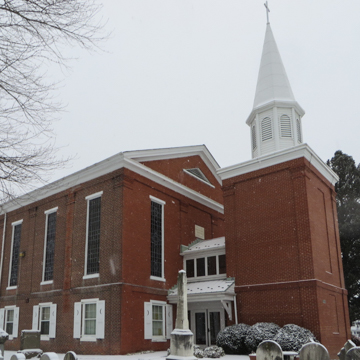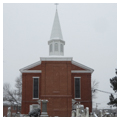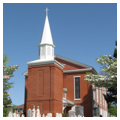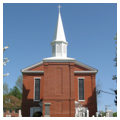Scots-Irish immigrants built a log structure on nearby Polly Drummond Hill in 1721. George Whitefield preached to 8,000 there in November 1739, which contributed to a subsequent rift among Presbyterians, with “New Side” Presbyterians, who liked him, departing to establish this church. (“New Side” or “New Light” referred to fervent revivalists inspired by the Great Awakening, as opposed to the more orthodox “Old Side.” Their local leader was Reverend Charles Tennent, son of the founder of the famous Log College, Pennsylvania.) This church was established in 1752, replaced in 1785, and again, in 1855, with the present structure. The current building is brick, of Greek Revival style with the sanctuary upstairs, Sunday school below, in an arrangement that was popular in the mid nineteenth century. Sanctuary walls and ceiling are covered with decorative sheet metal in Gothic and other historical patterns, and cast-iron columns support the floor. A dedicatory inscription of 1752 is displayed, along with a folk-art mural showing all four historic churches. Gravestones in the sizeable cemetery are said to go back to 1734; among the many made from marble stands a single green stone, apparently serpentine (1757). The lumpy cemetery wall of whitewashed rocks dates to 1785. The temple-form purity of the hilltop church was marred in 1996 when a stumpy tower was built beside it to house an elevator.
You are here
White Clay Creek Presbyterian Church
If SAH Archipedia has been useful to you, please consider supporting it.
SAH Archipedia tells the story of the United States through its buildings, landscapes, and cities. This freely available resource empowers the public with authoritative knowledge that deepens their understanding and appreciation of the built environment. But the Society of Architectural Historians, which created SAH Archipedia with University of Virginia Press, needs your support to maintain the high-caliber research, writing, photography, cartography, editing, design, and programming that make SAH Archipedia a trusted online resource available to all who value the history of place, heritage tourism, and learning.




























